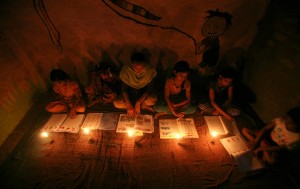 As we ended the month of July in 2012, India was in the midst of a blackout that left an estimated 650 million people without power, In fact, 20 of India’s 28 states were plunged into darkness. Why did this happen?
As we ended the month of July in 2012, India was in the midst of a blackout that left an estimated 650 million people without power, In fact, 20 of India’s 28 states were plunged into darkness. Why did this happen?
It all happened because of an aging electrical infrastructure with relatively few back-up power generating systems combined with rapid economic growth that has dramatically increased the need for energy. In other words, there is not enough energy production to satisfy current, not to mention future energy demands. And, from an energy transmission and distribution perspective, there have been problems for years due to the aging infrastructure and now with demand increasing every day, small problems can become large very fast. Could anyone have seen these problems coming and prevented them from happening in the first place?
As you might guess, the answer is yes. The vast majority of problems individuals, organizations, and nations face are fully predictable, but we are all too busy focusing on our current problems that we have little time allocated to focus on solving tomorrow’s predictable problems today.
Over the next five years there will be roughly five billion people entering the lower middle class in rapidly developing economies such as India, China and Indonesia—they will all want and need a lot of power.
Looking at India today in the blackout zone, (where 650 million people were without power) there are many more in that same zone who never had power to begin with—and they too will want power soon. For example, in one of the blackout zones in Bihar, only 16.4% of the 100 million people who live in that area have access to electricity. However in Punjab, a rapidly growing area a little to the west, 96.6% of the people have access to power. Overall, one-third of India’s households don’t have access to electricity, according to a 2011 census. So the use of electricity in India is unevenly dispersed. But that will change very quickly.
Will India have more blackout problems if they don’t act quickly to solve tomorrow’s predictable problem today? You know the answer is yes once again.
Why isn’t China having a similar problem? Well, China does have energy demand problems and infrastructure problems. However, India is a democracy and China is not. So when someone in India wants to put in a power plant or build a dam or do something similar, there’s voting that takes place and politics. For example, when China wants to build a gigantic hydroelectric dam, it’s just done, whether you like it or not. I’m not saying China’s way is better than a democracy. I’m just saying it makes things happen faster.
But rapidly growing power demands aren’t just overseas. Even in the United States, our energy infrastructure is aging rapidly. Utilities have already started converting to a smart grid, but politics are involved which slows things down and as a nation we have to ask, are we keeping up with our own expanding energy needs? After all, if we have smart phones, smart tablets, smart TVs, smart roads, and smart buildings, it doesn’t make sense to be plugging them into a dumb grid. So it’s not just the developing world that needs to move faster at converting its infrastructure. The developed world needs to catch up too.
As we look to the predictable future and see what is taking place in terms of technological transformation, growing energy needs, and the rapid economic upward mobility of billions of people going from poverty to lower-class and lower-middle class, we need to be anticipatory, solve tomorrow’s predictable problems today, not reactionary, focusing only on current problems. We need to work together with a new sense of urgency. We need to be preparing not only in developing countries for rapidly increasing predictable demand, but also turning our sights to our own country. We need not only a smart grid, but also a grid that’s capable of getting smarter every day, as our devices get smarter, so it can adapt and bring us successfully into the 21st century.







Comments